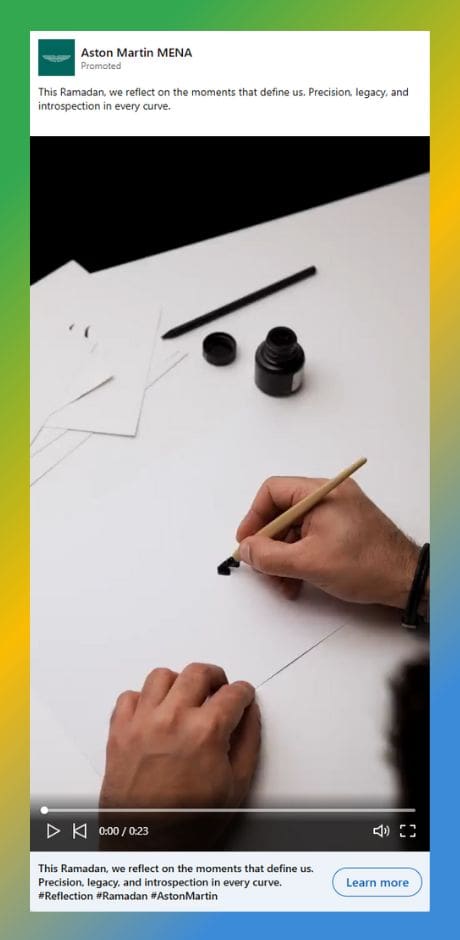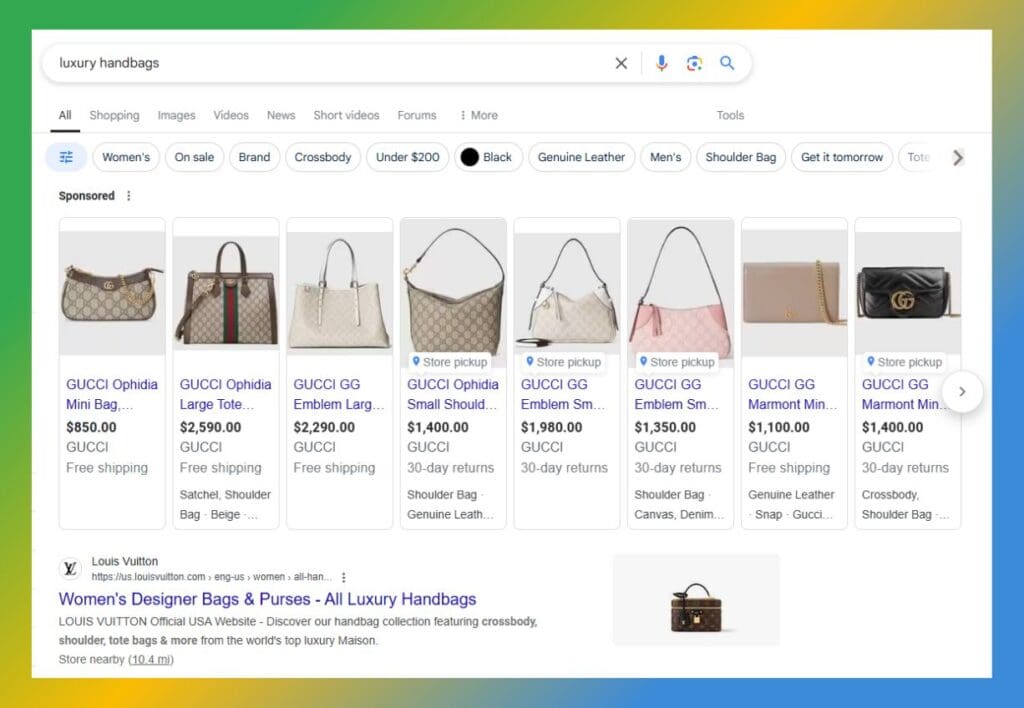
You may have heard that pay-per-click (PPC) doesn’t work for luxury brands. Maybe you’ve even tried running paid ads, and they flopped. Let’s start with a reality check: PPC does work for luxury brands. In fact, we’ll walk you through how some of the most iconic brands in the world approach PPC in just a moment. The problem, however, is that most marketers treat PPC as a quick-win channel. It can be for most companies, but that’s not how PPC for luxury brands works. The established elite know who they are and what they represent. They’re not out there trying to grab a quick sale. They’re playing the long game. You’ll learn how to do the same in this guide.
The Four Luxury PPC Archetypes (Based on Real Ad Behavior)
Before we move into strategy, stop and think for just a moment: what’s the difference between Rolex and Patek Philippe? Both are luxury watchmakers. Both target affluent audiences. On the surface, one could argue that they would require the same marketing strategy.
But, if you know watches or dig deeper, then you’d know the entry point for a Patek Philippe is nearly three times higher than that of a Rolex, and for good reasons. You might also know that Rolex gained mainstream popularity as generations watched James Bond don popular models ranging from the Submariner to the Daytona, as Watch Collectors reports. Yet, if you examine King Charles’ watch collection, you won’t find a Rolex there. One of his favorites, however, is the Patek Philippe Calatrava, according to Watch Finder & Co.

Despite their surface-level similarities, these brands are undeniably different and, therefore, must follow unique marketing strategies. In order for your brand to find any kind of lasting success, you will need to know where you fit into the hierarchy, too. To help simplify the process, we’ll break down luxury brands into four distinct archetypes below.
1. The Silent Status Icons
Some brands carry a timeless essence about them. Those in the know favor them and were likely indoctrinated into the culture at a young age. To describe them as “exclusive” would almost be an understatement. They don’t seek out an audience. Their audience seeks them. They often don’t even share their prices online. If you have to ask, you can’t afford them, as the saying goes.
These brands do not use PPC in a traditional sense. For instance, most companies at least run ads that show up when someone runs a search for one of their branded terms in Google. Silent Status Icons typically do not. The competition is so far behind that nothing could shake a potential buyer who is looking specifically for them. Whereas most retail brands run shopping ads, Silent Status Icons typically do not. Again, they may not even share their prices online, and they’re certainly not running sales.
Examples of Silent Status Icons
Patek Philippe is a prime example of a Silent Status Icon. Their slogan says it all: “You never actually own a Patek Philippe. You merely look after it for the next generation.” Other examples in this archetype include the French trunk maker Goyard and the luxury sports car manufacturer Aston Martin.
What Silent Status Icons Do
Silent Status Icons don’t usually show up in most paid ad formats, and that’s the point. Their timelessness, mystique, and exclusivity carry them. The exception to this is carefully curated ads on social media networks that leverage storytelling to strengthen their branding or carefully curated placements in advertising for elite events.
Take Aston Martin, for example. At present, the brand does not appear when you run a search for “Aston Martin” or even “luxury sports cars.” However, you will occasionally see their official LinkedIn account for the Middle East and North Africa (@astonmartinmena) run ads that deeply resonate with its audience and strengthen its branding.
How to Tell if Your Brand is a Silent Status Icon
It’s almost impossible for newer brands today to operate as a Silent Status Icon. Only a rare few can afford to delay revenue and let the brand grow slowly through reputation alone. If that’s you, this archetype may be worth considering.

2. The Curated Builders
Some luxury brands are unmistakably present in digital advertising, but never casually so. These brands understand the importance of discoverability, particularly for those who already know them. They participate in digital channels with a high degree of control, shaping how they appear and when. Their advertising doesn’t chase attention; it reflects a brand that’s already earned it.
You’ll see them in select spaces, often around collection launches, gifting seasons, or other brand-driven moments. But the tone is always consistent with the rest of the brand: thoughtful, deliberate, and designed to reinforce perception rather than drive urgency. These brands don’t simply advertise. They present themselves on their terms.
Examples of Curated Builders
Tiffany & Co. is a clear example of a Curated Builder. The brand protects its identity across channels, appearing in searches for its own name and select discovery-driven phrases such as “luxury gifts for her.” Other brands in this archetype include Rolex and the French fashion house Hermès, both of which maintain a controlled presence in paid search while using social advertising to reinforce their brand image through carefully timed, visually driven campaigns.

What Curated Builders Do
Curated Builders show up when it supports their brand and stay quiet when it doesn’t. Their advertising strategy focuses on reinforcing the existing brand experience, rather than expanding reach at any cost. That often includes paid search campaigns for branded terms, a presence in shopping feeds with tightly controlled creative, and social campaigns that echo the tone and pacing of the brand itself.
Consider Tiffany & Co. Their advertising often appears around seasonal milestones, supporting the gifting occasions they’re already known for. Hermès and Rolex take an even more selective approach, appearing primarily for brand-name searches while using social platforms to strengthen their voice through rich visuals and editorial storytelling.
How to Tell if Your Brand Is a Curated Builder
Your brand may be a Curated Builder if you already have a strong reputation or are in the process of building one and want to ensure that any advertising you do only enhances what you’ve established. You’re open to being seen, but not broadly. Your audience is already looking for you, or they’re close enough to know what to search for. Advertising, for you, is about meeting the right audience with the right tone at the right time.
3. The Prestige Expansives
These brands want to be found, and they aren’t afraid to take up space. They still carry the hallmarks of luxury: premium pricing, bold visual identity, and brand equity built over decades or more. But unlike more reserved brands, they’re comfortable competing in the public arena. Their campaigns are often highly visible across search, shopping, and social platforms. And while their ads maintain the polish expected of a luxury brand, their goal is clear: to engage, attract, and convert.
Where Silent Status Icons thrive on mystery and Curated Builders emphasize control, Prestige Expansives operate more like legacy publishers or fashion houses that embrace mass appeal. They advertise to reinforce their influence and ensure they remain top of mind when consumers are ready to buy.
Examples of Prestige Expansives
Gucci stands out here. The brand is a frequent presence in search results for product-specific and discovery-phase queries, including some non-branded phrases like “luxury handbags.” Shopping ads are common, with clean, creative, and consistent branding throughout. Louis Vuitton takes a similar approach, though its visibility can be more selective. In many cases, ads appear just below the fold or in secondary placements, still present but not aggressively so. Maserati is another example of a brand that embraces visibility, with a digital presence that reflects both performance and design-driven appeal.

What Prestige Expansives Do
Prestige Expansives are active participants in the digital space. They usually run ads across branded and non-branded keywords, maintain a presence in shopping feeds, and promote key campaigns through social and video platforms. Their ads are still elevated, but there’s no hesitation to speak directly to the customer. They invest heavily in visibility and are comfortable blending lifestyle messaging with performance goals.
How to Tell if Your Brand is a Prestige Expansive
Your brand may fall into this category if you have broad awareness and high cultural relevance, and you want to maintain that position while driving growth. You aren’t concerned about exclusivity. You’re focused on remaining top of mind for luxury buyers across a range of touchpoints. If your strategy includes frequent launches, trend alignment, and active campaign rotation, you’re likely operating in this space already.
4. The Prestige-for-Many Brands
These brands speak the language of luxury, but they do so at scale. Their products are aspirational but often within reach. Their price points are premium but not unattainable. And their marketing reflects this dual positioning: refined and styled to evoke exclusivity but delivered through accessible channels and conversion-focused campaigns.
This group embraces visibility. You’ll see their ads across search, shopping, social media, and display ad networks. Their creative often includes pricing, promotional offers, or time-sensitive language, especially when targeting newer audiences or seasonal shoppers. These brands understand that success requires reach, and they use PPC to find, engage, and convert buyers at every stage of the funnel.
Examples of Prestige-for-Many Brands
Michael Kors is a classic example. The brand uses shopping ads and paid search extensively, particularly around gifting seasons and promotional events. Coach operates similarly, focusing on design and affordability while maintaining a premium look and feel. In the automotive world, brands like Lexus and Cadillac reflect this model, with luxury messaging paired with widespread digital visibility and clearly defined performance goals.
What Prestige-for-Many Brands Do
These brands tend to run robust campaigns across nearly every available channel. They advertise for branded and non-branded terms, often targeting shoppers who are still exploring their options. Their shopping ads are designed to drive traffic, and their social campaigns blend lifestyle content with direct calls to action. They rarely hesitate to show pricing, offer promotions, or invite immediate engagement.

How to Tell if Your Brand is a Prestige-for-Many Brand
If your brand is emerging, price-accessible, and looking to grow through digital visibility, this is likely where you fit. You want to compete on quality and design, but you’re also prioritizing brand awareness, engagement, and sales. You’re building a brand, but you’re also running a business, and PPC plays a central role in helping you do both.
Strategy by Archetype: How Your Essence Shapes Your Ad Tactics
You’ve seen how different types of luxury brands approach advertising and how much those choices reflect their brand essence, but understanding your archetype is only the first step. The next is knowing how to translate that positioning into a practical PPC strategy.
In this section, we’ll explore how the four luxury archetypes tend to approach key campaign elements: targeting, platforms, creative, and budget. While no two brands are identical, patterns emerge, and understanding them can help you build a more consistent, intentional strategy.
Targeting
How you target says just as much about your brand as what you sell. The platforms you appear on, the keywords you bid on, and the audiences you define, or choose to ignore, all shape how your brand is perceived. The goal isn’t just to reach people. It’s to reach them in a way that aligns with your identity.

Silent Status Icons
You likely don’t rely on PPC as a core channel, and that’s intentional. Your targeting strategy should reflect this by being highly selective and moment-based, not audience-driven. When you do run campaigns, typically regional or seasonal, focus on moments that align with your brand’s heritage or values, not product discovery.
- Target Moments, Not People: Use cultural calendars and regional relevance to shape campaigns. You’re not trying to find your audience. They already know you.
- Work Through Regional Partners: If you’re a global brand, let localized divisions manage ad targeting to ensure cultural and tonal alignment.
- Let Your Absence Speak if You Can Afford It: Not bidding on your brand name or product category can reinforce exclusivity, but only if your brand is already known and protected. If you’re still emerging, leaving these terms unguarded opens the door to resellers or imitators who may undermine your image.
Curated Builders
Your brand has recognition, and now it’s about protecting and reinforcing that reputation. Your targeting should focus on those already seeking you out or who are just close enough to be let in. Use PPC to preserve your voice, not expand beyond it.
- Bid on Branded Terms: Make sure your name leads to the right destination; your own curated experience
- Use Discovery Terms Selectively: Phrases like “luxury gifts for her” or “fine Italian leather” can work if they align with your tone and product positioning.
- Lean on Lookalikes and Retargeting: Build audiences that reflect your current customers and engage those who’ve already interacted with you.
Prestige Expansives
You want to be found, and you have the brand equity to appear in broader spaces without losing your identity. Targeting should help you own the high-intent middle ground: not mass-market, but not invitation-only either.
- Include Category-Level Keywords: Terms like “designer handbags” or “luxury watches” help you reach consumers still deciding between brands.
- Layer in Lifestyle Signals: Affluent interests (luxury travel, high-end fashion, art collecting) can help filter for brand-aligned intent on social and display.
- Use Location as a Filter: Focus your efforts on major metros, high-income zip codes, or international hubs that match your buyer profile.
Prestige-for-Many Brands
PPC is a central part of your growth strategy, and targeting is where you scale. You’re aiming to reach new customers efficiently, repeatedly, and across multiple entry points.
- Use Broad and Long-Tail Keywords: Mix branded terms with discovery queries like “affordable luxury handbags” or “designer shoes under $500.”
- Segment by Behavior and Income: Use platform tools to filter by online shopping habits, income brackets, and interest in competitor brands.
- Build a Full-Funnel Audience Strategy: Capture new users through awareness, retarget based on product views or cart abandonment, and upsell past buyers.
Platforms and Ad Types
Every platform and format you choose reinforces your brand’s voice—or undermines it. In luxury, your digital presence should feel just as considered as your showroom or packaging. That doesn’t mean every channel is off-limits. It means using each one with intention, and only when it supports the experience you want to deliver.

Silent Status Icons
Your brand is built on mystique and legacy. If you choose to advertise, the platform must support storytelling, not selling.
- Use Story-Led Social Campaigns: Instagram, LinkedIn, or Facebook can support editorial-style storytelling around cultural moments, milestones, or collections.
- Avoid Performance-Heavy Channels: Search and Shopping ads prioritize comparison, price, and action, none of which support your brand image.
- Stick to Cinematic or Static Visuals: Use high-concept visuals with minimal copy. Think: digital lookbook, not digital storefront.
- Be Strategic with Any Entry Point: If you run a campaign, even once a year, ensure it aligns globally with your brand voice. This isn’t about traffic. It’s about maintaining presence with grace.
Curated Builders
You’ve established recognition. Your job now is to ensure that every ad impression feels like the brand: carefully composed, never rushed.
- Run Branded Search to Control Your Presence: Your name should lead to your official destination. Bid defensively to avoid losing traffic to resellers or marketplaces.
- Use Shopping Ads When You Can Control the Experience: Stick to consistent styling, minimal overlays, and quiet presentation. Don’t leverage discounts, countdowns, or urgency.
- Support Launches Through Social: Use Facebook and Instagram to showcase new collections or highlight brand themes. Let the visuals do the work.
- Explore Microsoft Ads for Brand Control: It’s often more affordable and can help you secure branded terms in a premium browsing environment, especially on desktop.
Prestige Expansives
You have the equity to be visible across channels. Use paid media to maintain top-of-mind presence, but never at the expense of tone.
- Support Campaigns Across Search, Shopping, and Social: Coordinate placements to support seasonal launches or product drops. Consistency matters more than ubiquity.
- Use Visual Formats with Gravitas: Prioritize platforms that support storytelling through short films, collection photography, and brand voice.
- Control How You Appear, Not Just Where: Always review how your brand is displayed within feeds, especially in shopping ads, where default formatting can strip context.
- Scale Mindfully with Microsoft Ads: If your Google campaigns are mature, Microsoft can offer an additional outlet for brand-aligned discovery and retargeting.
Prestige-for-Many Brands
Paid media is central to your strategy. You need platforms that deliver performance, without compromising your brand aesthetic.
- Run Multi-Platform, Full-Funnel Campaigns: Use Google, Meta, TikTok, Pinterest, and Microsoft to capture attention across every stage of the buyer journey.
- Design for Performance, Not Just Presence: Your ads should look premium, but they also need to drive action. Use clean overlays, smart copy, and mobile-first formats.
- Test and Iterate Often: You’re playing a volume game. Use A/B tests, dynamic formats, and platform tools to find what performs.
- Stretch Your Budget Where it Counts: Microsoft Ads may give you more reach for less, especially in branded search and retargeting to desktop buyers.
Creative Direction
Your ads may be the first or only touchpoint someone has with your brand. The visuals, tone, and messaging you choose need to reflect your identity instantly and unmistakably. Luxury brands don’t just “run ads.” They design every element to feel like a continuation of the brand experience. That means knowing where to show restraint, where to engage, and where to let the product speak for itself.

Silent Status Icons
Your creative should reinforce exclusivity, not chase attention. This isn’t the place for urgency or calls to action. It’s about elegance, quiet confidence, and cultural alignment.
- Use Visuals That Reflect Legacy: Showcase craftsmanship, heritage, or symbolic elements that tie into tradition.
- Minimize Copy: Let the visuals carry the story. If text is used, keep it sparse, with a tone that reflects refinement and permanence.
- Avoid Pricing or Promotional Language: Your value is self-evident. Showing price, or even showing too many products, can dilute the mystique.
- Align with Moments, Not Campaigns: When you advertise, do it to mark a milestone or story, not to push product.
Curated Builders
Your creative needs to look and feel like your brand, offline and on. It should feel consistent, editorial, and intentional, with every element serving to elevate rather than persuade.
- Prioritize Brand-Led Imagery: Use clean backdrops, signature brand colors, and consistent styling across assets.
- Let Your Collection Lead: Feature a small number of products or one hero piece. Avoid cluttered layouts or rotating promos.
- Write with Restraint: Headlines can be collection names or an elegant statement; never “Shop Now” or “Limited Time.”
- Ensure Format Matches Message: Use ad types that give your visuals room to breathe. Use single-image, carousel, or video formats that let your tone and aesthetic take center stage.
Prestige Expansives
You have room to explore creative territory, as long as the look, feel, and tone still reflect who you are. You’re balancing storytelling and scale, so your creative should feel luxurious but accessible.
- Use High-Production Visuals Across Platforms: Think cinematic video, rich product detail shots, and aspirational lifestyle imagery.
- Evolve Your Voice Without Losing It: You can match platform energy by using Reels, Stories, and YouTube Shorts while still maintaining control over color palette, tone, and cadence.
- Tie Creative to Key Campaign Themes: Let each season or product launch have a clear visual identity that carries across formats.
- Balance Brand and Product: You can show pricing and products, but pair them with aspirational language and imagery that reinforces the emotional value.
Prestige-for-Many Brands
Your creative needs to work hard, but that doesn’t mean it should look transactional. Your audience wants the feeling of luxury and the confidence to click. Your job is to deliver both.
- Use Clean, Conversion-Friendly Layouts: Show product clearly, with consistent lighting, brand-consistent fonts, and a strong visual hierarchy.
- Include Pricing and CTAs Elegantly: You can use “Shop Now” or show price if it’s part of your strategy, but style it thoughtfully so it feels like an invitation, not a pitch.
- Test Formats Aggressively: Run variations of image, video, carousel, and collection ads to learn what drives performance without compromising tone.
- Anchor Performance in Identity: As you scale, protect your brand by aligning every creative element, from color to copy, with your established look and feel.
Budget and Bidding
In luxury, how you spend matters just as much as how much you spend. You’re not just managing cost; you’re protecting perception. The size of your PPC budget will vary based on your brand’s stage and strategy, but the proportion, intention, and execution need to align with the experience you’re offering. At the same time, you’re not advertising alone. Competitors are bidding alongside you; some strategically, some indiscriminately. Your job is to show up where it makes sense and bow out where it doesn’t.

Silent Status Icons
Paid advertising isn’t core to your strategy, and that’s the point. But when you do invest, you must do it with precision and intent.
- Treat Spend as Symbolic: Use your budget to support rare, brand-led campaigns, not to chase performance metrics.
- Cap Budget Tightly: Define a clear limit that reflects the purpose of the campaign, whether it’s seasonal storytelling or a regional activation.
- Avoid ROAS Thinking: Don’t judge success by clicks or conversions. Your spend is about reinforcing brand stature, not generating leads.
- Be Aware of Competitive Gaps: Leaving brand terms unprotected may invite resellers or copycats who dilute your narrative. If you choose silence, do so with your eyes open.
Curated Builders
You’re not here to dominate. You’re here to stay consistent. But protecting your space may require bidding in more places than you expect.
- Allocate a Small, Intentional Share of Budget: Paid media may represent a fraction of your total spend, and that’s appropriate for your brand.
- Use Bidding Defensively: Own your branded keywords. Control the buyer’s first impression, even if they already know your name.
- Prioritize Experience Over Efficiency: Choose placements and bidding strategies that support a seamless brand handoff from ad to site.
- Expect Aggression from Below: Prestige-for-Many brands may bid on your category or even on your brand. Stay aware of who’s showing up alongside you, and don’t let their presence define your narrative.
Prestige Expansives
You need to be seen, but never at the expense of tone. Your investment must protect your image while keeping you present in all the right places.
- Use a Flexible Budget: Support seasonal spikes and ongoing visibility, but avoid always-on spending that lacks context.
- Blend Brand and Performance Goals: Bid for visibility, but ensure each campaign supports your broader brand identity.
- Leverage Smart Bidding with Guardrails: Automation can help you scale, but you’ll need checks in place to avoid low-quality placements.
- Choose Auctions That Match Your Brand Standards: Don’t chase every impression. Focus your bids on placements where you can show up at full strength, without compromising tone, context, or positioning.
Prestige-for-Many Brands
You’re in a performance-driven space, and PPC is your strongest lever. But your challenge is bidding smartly and staying premium, especially when competitors can beat you on both brand and budget.
- Dedicate a Meaningful Portion of Your Budget to Paid Advertising: This is likely your biggest driver of visibility and growth. Plan accordingly.
- Use Automated Bidding to Scale: Smart bidding can help you compete in broad auctions without manual oversight, but make sure it aligns with brand expectations.
- Segment Budgets by Funnel Stage: Don’t let top-of-funnel needs overwhelm bottom-of-funnel precision.
- You’re Fighting Up and Down the Ladder: Silent Icons may show up sparingly, but dominate when they do. Down-market brands may undercut on price and flood the auction. You win by knowing exactly where your edge lies and not trying to outspend everyone, everywhere.
Regional and Cultural Nuances
Luxury doesn’t look the same in every market. What’s aspirational in London might seem understated in Dubai, or overly bold in Tokyo. If you’re expanding into new regions, or even advertising to international buyers online, your messaging, creative, and timing need to respect the expectations and values of the local audience.

You don’t need to build fully localized strategies for every market. But you do need to recognize that what works in your home region may not translate cleanly elsewhere. Here’s how to approach that, based on your brand positioning.
Silent Status Icons
Brands in this category often avoid advertising altogether, but when they do run campaigns, they do so with cultural depth and precision. While you may not be in this tier yet, there’s a lot to learn from how these brands treat regional nuance.
- Campaigns Reflect Culture, Not Urgency: Elite brands often anchor campaigns around globally recognized moments like Christmas or Lunar New Year, but the tone is celebratory, not promotional. These ads highlight heritage, craftsmanship, or emotion, not sales or scarcity.
- Tone and Imagery Are Regionally Informed: While their core identity stays the same, creative elements, like location, styling, and language, are adjusted to reflect the audience’s world.
- Presence is Strategic, Not Constant: Ads may only run in certain markets or regions where the brand is growing influence, not where it’s already established.
Curated Builders
You’ve worked hard to build a controlled, consistent brand. That consistency still matters when advertising internationally, but you’ll need to make space for local nuance without losing the thread.
- Adjust Creative to Local Expectations: A minimal aesthetic may signal refinement in North America but feel too plain elsewhere. Adapt styling and color without sacrificing your identity.
- Be Sensitive to Symbolism: Colors, gestures, and even language phrasing carry different weight across cultures. Use native speakers and regional creatives where possible.
- Use Paid Ads to Signal Presence, Not Promotion: If you’re entering a new market, consider running branded ads simply to establish authority, not to push sales.
- Advertise Around Regional Moments: Holidays like Ramadan, Lunar New Year, or Diwali may offer better brand alignment than U.S.-centric events like Black Friday in certain markets.
Prestige Expansives
You may already be advertising in multiple countries or planning global campaigns. Just be careful not to flatten your voice in an effort to simplify.
- Localize Messaging Without Losing Voice: You can (and should) translate for local markets, but preserve brand tone and visual consistency.
- Let Regional Context Enhance, Not Diminish: Incorporate local backdrops, talent, or references where appropriate. These cues help you feel present without forcing fit.
- Plan Campaign Timing Around Local Calendars: Shopping cycles vary. A “holiday gift guide” in the U.S. may not land in the same way abroad.
- Watch Awareness Levels: Even if you’re a household name in one country, you may still be in discovery mode elsewhere. Adjust funnel strategies accordingly.
Prestige-for-Many Brands
You may be entering new regions for the first time, and these are moments that matter. Getting the tone wrong can undercut trust before a user even clicks. Getting it right can elevate your entire brand.
- Start with Cultural Discovery: Look at local definitions of luxury. What’s aspirational? What price points signal quality? Don’t assume they’ll match your home market.
- Work with Local Partners: Even simple translation can misfire without cultural context. Use regional freelancers, agencies, or internal reviewers to catch misalignments.
- Respect the Role of Paid Advertising Locally: In some markets, PPC is seen as a legitimate brand-building tool. In others, it’s associated with discount-driven retail. Understand the perception before you launch.
- Choose Channels Based on Local Behavior: Instagram might dominate in Canada, but in the UK, Google Shopping may be stronger. Let real consumer habits, not assumptions, guide your platform mix.
Build a PPC Strategy That Matches Your Luxury Brand
Strong luxury PPC strategies rely on alignment. When your targeting, creative, and channel choices reflect your brand’s true essence, performance follows. If you’re ready to build a smarter, more strategic approach to paid advertising, we’ll match you with an agency that understands how to elevate luxury brands without compromising their identity. Request a complimentary consultation to get started.
FAQs on PPC for Luxury Brands
How can brands create an effective PPC strategy for premium products?
A strong PPC strategy for premium brands begins with clearly defined brand positioning. Everything, from platform selection to ad copy and bidding, should reflect the value of the product and the expectations of a high-end consumer. Campaigns must strike a balance between performance and perception to deliver effective PPC for luxury brands.
Is it worth running PPC ads for high-end products?
Absolutely. High-end product PPC can drive both visibility and conversions when executed with the right strategy. The key is resisting the urge to chase low-cost clicks and instead focusing on quality placements that resonate with the intended audience.
What are some best practices for targeting affluent audiences with PPC?
Targeting affluent audiences PPC strategies often involve layering demographics with behavioral data, luxury-related interests, and purchase intent. Geotargeting can also help isolate high-income neighborhoods or cities known for luxury buying behavior.
How does geotargeting apply to luxury brand campaigns?
Geotargeting for luxury brands allows marketers to focus on specific zip codes, regions, or countries where luxury demand is highest. This strategy is particularly useful for localized campaigns, new store openings, or events in affluent areas.
What’s the role of PPC in luxury brand promotion strategies?
Luxury brand promotion strategies often include PPC as a tool to support seasonal campaigns, product launches, or controlled discovery. When handled with precision, PPC can reinforce brand equity while expanding reach.
What’s the best way to approach luxury product advertising with PPC?
Luxury product advertising with PPC should emphasize storytelling, visual quality, and brand consistency. High-quality creative and thoughtful messaging are essential for making an impression that aligns with the premium nature of the product.
How can niche luxury brands make PPC work for them?
Luxury niche ad targeting helps smaller or emerging luxury brands reach a very specific audience without wasting spend. By narrowing focus with interest targeting, custom audiences, or competitor lookalikes, these brands can attract high-quality leads while preserving exclusivity.
How does PPC fit into the luxury market as a whole?
The luxury market pay-per-click landscape is highly competitive but rewarding for brands that understand their audience. It’s less about chasing conversions and more about reinforcing brand value at every touchpoint.
What should luxury brands consider when developing advertising strategies?
The most successful luxury brand advertising strategies prioritize brand integrity above all else. That means selecting platforms and placements that reflect the brand’s tone, using creative that feels elevated and consistent, and approaching performance metrics with a long-term view. Whether the goal is awareness or conversion, every element of the campaign should reinforce the brand’s essence.


















